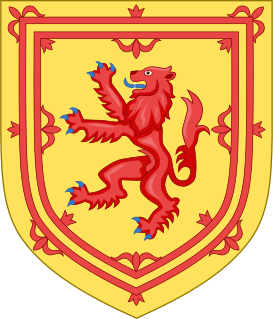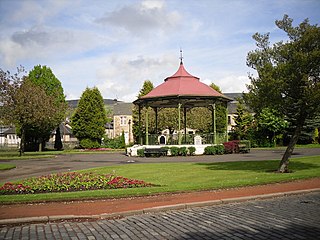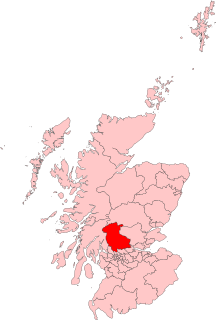Related Research Articles

Stirling is a city in central Scotland, 26 miles (42 km) northeast of Glasgow and 37 miles (60 km) north-west of Edinburgh. The market town, surrounded by rich farmland, grew up connecting the royal citadel, the medieval old town with its merchants and tradesmen, the Old Bridge and the port. Located on the River Forth, Stirling is the administrative centre for the Stirling council area, and is traditionally the county town of Stirlingshire. Proverbially it is the strategically important "Gateway to the Highlands".

Falkirk is one of 32 unitary authority council areas of Scotland. It was formed on 1 April 1996 by way of the Local Government etc. (Scotland) Act 1994 from the exact boundaries of Falkirk District, one of three parts of the Central region created in 1975, which was abolished at that time. Prior to the 1975 reorganisation, the majority of the council area was part of the historic county of Stirlingshire, and a small part, namely Bo'ness and Blackness, was part of the former county of West Lothian.

Local government in Scotland is organised through 32 unitary authorities designated as councils which consist of councillors elected every five years by registered voters in each of the council areas.

A burgh is an autonomous municipal corporation in Scotland and Northern England, usually a city, town, or toun in Scots. This type of administrative division existed from the 12th century, when King David I created the first royal burghs. Burgh status was broadly analogous to borough status, found in the rest of the United Kingdom. Following local government reorganisation in 1975, the title of "royal burgh" remains in use in many towns, but now has little more than ceremonial value.

Stirlingshire or the County of Stirling, Scottish Gaelic: Siorrachd Sruighlea) is a historic county and registration county of Scotland. Its county town is Stirling.

The Stirling council area is one of the 32 council areas of Scotland, and has a population of about 94,330. It was created under the Local Government etc (Scotland) Act 1994 with the boundaries of the Stirling district of the former Central local government region, and it covers most of Stirlingshire and the south-western portion of Perthshire. Both counties were abolished for local government purposes under the Local Government (Scotland) Act 1973.

Kilsyth is a town and civil parish in North Lanarkshire, roughly halfway between Glasgow and Stirling in Scotland. The estimated population is 9,860. The town is famous for the Battle of Kilsyth and the religious revivals of the 18th, 19th, and 20th centuries. The town now has links with Cumbernauld at one time being part of Cumbernauld and Kilsyth District Council. The towns also have the same members of parliament at Holyrood and Westminster.
Municipal boroughs were a type of local government district which existed in England and Wales between 1835 and 1974, in Northern Ireland from 1840 to 1973 and in the Republic of Ireland from 1840 to 2002. Broadly similar structures existed in Scotland from 1833 to 1975 with the reform of royal burghs and creation of police burghs.
Provost is a title held by the civic heads of local governments in Scotland. It is similar in use to the title of mayor in other parts of the English-speaking world.

Stirling is a county constituency of the House of Commons of the Parliament of the United Kingdom. It elects one Member of Parliament (MP) by the first past the post system of election.
West Stirlingshire was a county constituency of the House of Commons of the Parliament of the United Kingdom, to which it elected one Member of Parliament (MP) by the first past the post electoral system.
The Local Government (Scotland) Act 1889 is an Act of the Parliament of the United Kingdom which was passed on 26 August 1889. The main effect of the Act was to establish elected county councils in Scotland. In this it followed the pattern introduced in England and Wales by the Local Government Act 1888.
A police burgh was a Scottish burgh which had adopted a "police system" for governing the town. They existed from 1833 to 1975.
Stirling Burghs was a district of burghs constituency of the House of Commons of the Parliament of the United Kingdom from 1708 to 1918.

Slamannan is a village in the south of the Falkirk council area in Central Scotland. It is 4.6 miles (7.4 km) south-west of Falkirk, 6.0 miles (9.7 km) east of Cumbernauld and 7.1 miles (11.4 km) north-east of Airdrie.

The City of Edinburgh Council is the local government authority for the City of Edinburgh. It was created in 1996 under the Local Government etc. (Scotland) Act 1994, with the boundaries of the post-1975 City of Edinburgh District Council of the Lothian region.
Stirling in Stirlingshire was a royal burgh that returned one commissioner to the Parliament of Scotland and to the Convention of Estates.

Mote Hill is the northern tip of the Gowanhills, Stirling, the northern half of the Royal Park that extends around Stirling Castle. The wider park includes the King's Knott and sections of a 2-metre-high deer wall, first established in the 12th century, though Gowan Hill only became park of the Royal Park around 1500.
Henry Cunningham, of Boquhan, Gorgunnock, Stirling, was a Scottish Whig politician who sat in the House of Commons from 1709 to 1734. He was given the post of Governor of Jamaica, but died two months after landing there. A description of Cunningham appears in the introduction to Scott’s historical novel ‘’Rob Roy’’.
Sir Samuel McClellan, MacClellan or McLellan was a Scottish cloth merchant and politician who sat in the House of Commons of Great Britain from 1708 to 1709. He served as Lord Provost of Edinburgh from 1706 to 1708.
References
- 1 2 3 4 5 6 Connell, Arthur (1827). A Treatise on the Election Laws in Scotland. William Blackwood. p. 305.
- ↑ Mackenzie, J. H. (1819). Memorial for the late Magistrates and Town Council of the burgh of Inverness; and for the Heritors and Burgesses, petitioners with the Magistrates for a Royal Warrant. p. 51.
- 1 2 3 4 Muirhead, Andrew T. N. Stirling's churches and the town of Stirling, 1560–1800 (PDF). Retrieved 10 January 2019.
- ↑ Nimmo, William (1817). History of Stirlingshire. Corrected and brought down to the present time by W.M. Stirling. p. 338. Retrieved 10 January 2019.
- 1 2 3 Forbes, John (1848). The Tourist's Companion Through Stirling, Embracing Tours to the Trosachs, Aberfoyle and the Rumbling Bridge. Also, a Guide from Edinburgh to Stirling. Editor. p. 7. Retrieved 10 January 2019.
- 1 2 Connell, Arthur (1827). A Treatise on the Election Laws in Scotland. William Blackwood. p. 306.
- 1 2 Mackenzie, J. H. (1819). Memorial for the late Magistrates and Town Council of the burgh of Inverness; and for the Heritors and Burgesses, petitioners with the Magistrates for a Royal Warrant. p. 52.
- ↑ The New Statistical Account of Scotland: Dunbarton, Stirling, Clackmannan. W. Blackwood and Sons. 1845. p. 412.
- 1 2 Commissioners appointed to inquire into the state of municipal corporations in Scotland (1835). Local Reports of the Commissioners Presented to Both Houses of Parliament by Command of His Majesty. W. Clowes and sons. p. 403. Retrieved 10 January 2019.
- ↑ Parliamentary Papers. H.M. Stationery Office. 1821. p. 97.
- ↑ Nimmo, William (1817). History of Stirlingshire. Corrected and brought down to the present time by W.M. Stirling. pp. 335–337. Retrieved 10 January 2019.